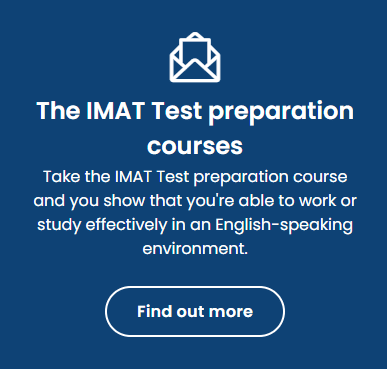

IMAT Exam Overview
The IMAT, or International Medical Admissions Test, is a mandatory entrance examination for studying dentistry and medicine in Italy. Designed by Cambridge Assessment in cooperation with the Italian Ministry of Education, it can be taken at over 30 cities across the world. Moreover, your score is valid for one year.
IMAT is a pen and pencil test which lasts for 100 minutes and consists of four papers. Moreover, all the questions are in English since the IMAT is for students who wish to study medicine and surgery and dentistry courses taught in English at Italian universities.
Which Italian universities require the IMAT?
The following Italian public universities offer medical courses taught in English and demand the IMAT:
– University of Milan
– La Sapienza
– Tor Vergata Milan-Bicocca University
– University of Bari
– Luigi Vanvitelli University
– University of Siena
– University of Bologna
– University of Pavia
– University of Turin
– Federico V University
– University of Padova
– University of Parma
This list is regularly updated from academic year to year. Check with Elab before starting your applications to Italian medical schools for the very latest information.
What is a good score in the IMAT?
The maximum you can score in the IMAT is 90 points, since you will be answering 60 questions and will be allotted 1.5 for every correct answer, 0 for not answering a question and 0.4 will be deducted from your total marks for every wrong answer. Overall, guessing answers in the IMAT is not a brilliant idea.
In 2020, the average score posted by EU students applying to IMS Milan was 57.8, with applicants to the University of Bari averaging 51. It is generally believed that medical schools will not consider applicants who gain less than 45 in the IMAT. However, remember that you can apply to as many Italian medical schools as you like. It might be worth trying for a number of differently-ranked institutions to maximise your chances of getting a place. Medical schools in Italy set aside a certain number of places for EU students – as well as non-EU students – and the figures change from year to year, as do the odds of being accepted. If you would like some advice on where to apply, contact Elab. We will go through your options with you.
How do I book to sit the IMAT?
You will need to:
– register on the University website before you can
– register for the IMAT through that portal.
You must book your test by 22 July,15.00 CEST, and the booking service opens on 4 July at 0900 CEST. Then, you will receive a confirmation email, which you need to hold on to, along with the date and time of your test. In 2022, the IMAT exam date is 13 September. There may be however slight variations depending on the centre where you will be sitting the IMAT. You cannot do the test online or outside an appointed centre. It is often the British Council in your own country.
You will need to pay a fee and keep the receipt, since you will be asked to produce it when you go to do the test. Currently, the IMAT fee is: £114/ 130 euros/ $164.
How do I prepare for the IMAT?
The IMAT tests what you have already learned at high school by asking you to apply facts and principles to examples, as well as evaluating your general knowledge and ability to think logically. The best way of getting a good score in the IMAT is to familiarise yourself with the format and the types of multiple-choice questions you will find, and to develop useful techniques which will help you complete the entire test in time.
Elab runs highly rated GetinMed workshops which include IMAT preparation, and can help you to tackle the IMAT with confidence and accuracy. Get in touch with Elab for start dates and further information, so you are well-prepared to sit the IMAT and get a great score!
IMAT Sections
Paper 1: Logical Reasoning and General Knowledge
Logical reasoning – 10 questions
General knowledge – 12 questions
This section can be divided into three. Futhermore, the logical reasoning looks at two elements: problem-solving and critical thinking. Hence, you will have 5 questions to answer on each.
Critical thinking can come in 7 types of questions:
- Summarising conclusions
- Reaching a conclusion on the basis of what you read in a text
- Discovering the assumptions in the text
- Assessing the effect of additional information
- Identifying errors in reasoning
- Parallel reasoning, namely finding a statement which follows from what you have been told
- Applying principles to a situation
You need to demonstrate that you can grasp an argument and make logical inferences from the given information and apply it to a specific situation.
Problem-solving asks you to use your spatial and numerical skills to find answers to the questions. Generally, this involves:
- Finding procedures
- Identifying similarity
- Making the relevant selection between options.
General knowledge tends to focus on five areas:
- Literature
- The history of science
- History and culture
- International organisations
- Philosophy
For example, you may be given a list of five authors and their work, and asked to identify which one is incorrect/ which was written first/ which author is not European etc.
Similarly, you could be presented with an acronym, such as the NATO, and be asked what the “T” stands for, or what the Rosetta Stone was used to decipher?
As long as you are reasonably well-read and keep up with international news, you should find this section of the paper quite easy, and it is worth brushing up on your general knowledge, since it offers you a chance to gain 18 points, towards your total.


Paper 2: Biology – 18 questions
It is obvious that the biology paper is a major part of the IMAT, given that you are hoping to study the human body, whether for dentistry or medicine and surgery.
There are four areas which often appear in the IMAT questions:
- Anatomy and physiology
- Cell theory
- Cell cycle and reproduction
- Genetics
In addition, you should revise other topics, such as:
Bioenergetics: Redox reactions, energy currency of cells, photosynthesis, glycolysis etc.
Reproduction and inheritance: life cycles, Mendel’s laws, human genetics, hereditary diseases etc.
Inheritance and environment: mutations, natural selection, artificial selection, genetics as foundation of evolution.
The chemistry of living things: enzymes, organic molecules and their function etc.
For instance, they may ask you to choose between definitions of the function of cholesterol, to analyse the graph of how a blood cell count has evolved over time and choose the right explanation or to look at a diagram of inheritance patterns of polydactyly and draw conclusions.
If you are short of time, or feel that you are weak in certain areas of biology, you would be well advised to focus on the first four subjects listed above, before moving on to more general revision. Remember, you do not have to learn new material. Make sure that you have the basic knowledge of biology and its processes and systems, which will enable you to apply what you have learned to the questions and examples in the IMAT.
Paper 3: Chemistry – 12 questions
There are four areas which often appear in the IMAT questions:
- Organic chemistry
- Bonds and molecular geometry
- Atomic structure
- The Periodic Table
In addition, you should revise:
- Acids and bases
- Oxidation and reduction
- Solutions
- Chemical reactions
- Inorganic chemistry
- Composition of matter
For example, questions may be about tissue transplants and matching antigens or chemical formulas.
Section 4: Physics and Mathematics – 4 questions each
Physics
In fact, most physics papers in the IMAT include questions on:
- Electricity
- Thermodynamics
- Mechanics
- Kinematics
Make sure you are up to speed on Measures, Dynamics, Electrostasis and Electrodynamics, in order to do well in this section. Expect questions on speed and acceleration, pressure and forces.
Mathematics
Judging by past IMAT papers, you are likely to be asked questions associated with exponents, algebra and geometry. Moreover, you should also revise Probability and Statistics, as well as Functions, to ensure that you get a high score in this part of the IMAT.
What do I need to bring to the IMAT test?
Some centres supply you with pens, and if they do not then you will need to bring two black pens. You cannot use a calculator or have a copy of the Periodic Table with you when you sit the IMAT. Arrive in good time and make sure you have your ID with you, the payment receipt and the confirmation email you received when registering for the IMAT.
Finally, do not panic.
You are not the first to sit the IMAT, with 7,800 applicants doing the test in 2020 alone. The IMAT is not designed to trick you, but to determine whether you can apply what you have learned in high school to a number of questions across biology, chemistry, physics and mathematics. Finally, think of the reward – a place studying medicine and surgery or dentistry in one of Italy’s outstanding medical schools. The goal is worth the revision and the nerves, so good luck and shine in the IMAT. Moreover, you can do it!
If you would like any additional information on the IMAT or to talk through choosing a medical school in Italy, then call or email us here at Elab. We have two offices in Italy – in Rome and Milan – and know our way around the education system, the universities and medical applications. Above all, we are here to help… so get in touch.
Study abroad with Elab - reviews from our applicants:
Students who study abroad have very positive opinions of
the courses and life in general. Below are a few examples of opinions from Elabs students studying abroad or who recently completed their studies:





